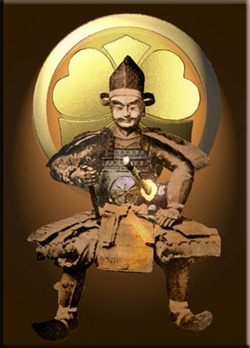 Hayashizaki Jinsuke Shigenobu In the book known as the Bugei Ryūha Daijiten (武芸流派大事典) which translates into English as the "Encyclopedia of Martial Art Schools", Hayashizaki Jinsuke Shigenobu (林崎 甚助 重信) (c.1542-1621) is given credit with establishing the Japanese art of iaijutsu (居合術) in the mid-16th century.
While the details of Hayashizaki's life have long been shrouded by the mists of time, many legends have passed down through the centuries that can help today's practitioners of the art that he pioneered catch a glimpse as to who this influential figure may have been and provide further insight into the art to which they devote themselves.
It is believed that Hayashizaki was born in Dewa Province, Ōshū (present-day Yamagata Prefecture) and lived for much of his life in what is now Kanagawa Prefecture. He was born during a violent time in Japan's long history when the entire country was embroiled in constant brutal warfare. As a member of the samurai warrior caste, Hayashizaki was exposed to many different styles of swordfighting from the time he was a young boy.
Legend tells us that when Hayashizaki was 14 years old his father was murdered by a warrior belonging to a rival samurai clan. As was custom at the time, it fell upon the shoulders of Hayashizaki to seek vengeance for his father's death to preserve his family's honor.
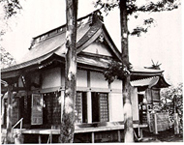 Hayashizaki Shrine In order to develop a strategy to defeat his more experienced foe, Hayashizaki retreated to the Tenshinsho Hayashizaki Myojin Shrine to meditate and train. It was here after nearly 100 days of prayer to the Kami that he was inspired by a dream to develop new techniques allowing him to effectively draw the sword and execute a lethal cut in one single unified motion. He called his new techniques "Muso-ken" which translates to "Dream-sword" and refined them to a level that was before yet unseen.
It was this strategy that ultimately allowed Hayashizaki to go on to defeat his more seasoned adversary, thereby avenging his father's death and establishing the foundation of a new class of martial arts - battojutsu (抜刀術), the art of sword drawing.
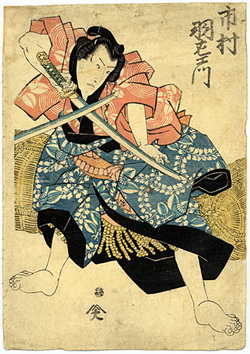 Hayashizaki continued to train and develop his technique and later taught family members his revolutionary style of swordsmanship which was dedicated primarily to drawing the sword. He became known as a talented martial arts instructor and was sought by many famous swordsman for guidance in order to increase their proficiency, while others adopted similar strategies and techniques to those of Hayashizaki's to enhance their own methodologies of combat.
For over 400 years the essence of Hayashizaki's divinely inspired teachings have since been transmitted via multiple schools from teacher to student. As time passed specialization in these techniques took on the name of iaijutsu, and has since continued to evolve into the method for spiritual development and fortification of character known today as iaido (居合道).
"The "Book of Wind", the fourth chapter, is not about my own style but rather about the other martial arts and their various styles... The Chinese character for "wind" also means "styles", modern styles, and styles in the various schools; I will here clearly explain the martial arts in this country as well as the techniques of their various styles."
-Miyamoto Musashi, The Go Rin no Sho - The Book of Earth (1644)
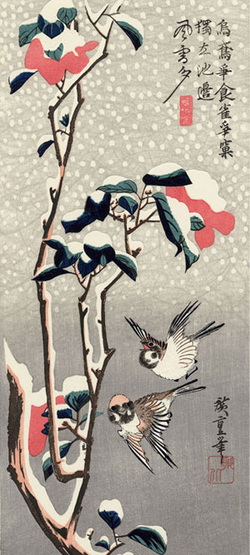 All manifestations of the various styles of Budo are expressions of an individual practitioner's cumulative study spanning back through generations of teachers and students. They are living art-forms and continue to evolve. That is why lineage speaks volumes about a practitioner's "style" and why schools and budoka of the same "style" can be so different.
It is important to keep in mind that as Musashi eludes to in the quote above, the kanji used for "ryu" 流 in the name of a Budo school also has the meaning of "flow/stream/trend" which he compares poetically to wind.
The concept of a "style" in the martial arts is not solid, but is rather dynamic and fluid. It is a flow of consciousness handed down from teacher to student, heart to heart, mind to mind. It is just as unconcrete, ephemeral and ethereal as the wind.
A "ryu" is a breeze blowing in the direction one must travel along the Way. Studying the techniques of a "ryu" is as following the swirling dead leaves carried by the wind along the path.
Practice what is in the book line by line, engage your opponents, and
gradually you will grasp the principle of the Way. Keep things
unceasingly in mind, but do not be hurried; try your hand from time to
time, and learn the heart of each step. And no matter whom you fight,
know his mind...
If these principles are recalled to mind, you should be able to
discern how to beat any number of opponents on your own. This being
so, grasp the Way of the Martial Arts with the strength of your
knowledge of swordsmanship, for many opponents or only one. See to it
that you temper yourself with one thousand days of practice, and
refine yourself with then thousand days of training.
You should investigate this thoroughly.
Twelth Day of the Fifth Month, Second Year of Shoho (1644)
Shinmen Musashi
(From the "Go Rin no Sho", the Book of Water) Well, I've had some time to reflect on the experience of making the journey up to Guelph. It was an awesome quest that far exceeded the expectations that I had tried in vain to mute. I extend my most sincere gratitude to Taylor Sensei for sharing his time and vast wealth of knowledge with me. Also, to his deshi, Pam Morgan.
I will cherish the techniques and ideas I was able to come away with and I will assuredly continue to incorporate them into my training in the future. I sincerely look forward to making the trip again to the Sei Do Kai in the spring in order to continue my study of the richly engaging and devastating art of Musashi's Nitenichi-ryu.
But there was another dimension to the trip, beyond gaining technical knowledge that the experience yielded.
I'll sum it up this way:
I often think of Budo as a path that one travels, and I guess I've been walking it for quite some time now. I may have strayed from it at times, or I might have had to sit under a tree and rest at others; but when I really think back about it, I've been able to move some distance down the road over the years.
Going up to Guelph was like finding myself on this path at the foot of a mountain and seeing the path ahead of me, winding up the to the peak; after a long climb I reached the summit only to find the path continuing down the other side and off into the distant horizon, where another range of mountains wait. Musashi said, "The journey of a thousand ri proceeds step by step..."
So I take another step on my journey.
Tomorrow morning I plan to wake up early and head down to a dojo about an hour from here to study with a well-known Sensei that was suggested by Taylor Sensei in order to possibly study the Koryu arts of Shinto Muso Ryu Jodo and Shinto Hatakage Ryu Iai Heiho .
"One Zen custom used by classical warriors and adopted by the exponents of the classical budo forms is "musha-shugyo", a kind of "austere training in warriorship." Musha-shugyo requires the trainee to travel in monklike fashion, living simply and exposing himself to natural hardships in the course of travel. At the same time this voluntary pattern of life involves him in training sessions in as many different dojos as he can enter. Musha-shugyo is indispensable to the trainee at the jutsu level of skill and is a path of rugged endeavor that is prerequisite for mastery of the Way."
- Donn Draeger (1922-1982), in "Classical Budo" Today I leave to make the 4 hour drive from my home in Troy, Michigan up to the University of Guelph just south of Toronto. I will stay the night at a hotel, then in the morning head to the Univeristy's Athletic Center to train with their Iaido club, the Sei Do Kai. They are preparing for their Yudansha Shinsa (Black-belt ranking exams) that are taking place next weekend and are as such holding a 7 hour marathon training session in order to hone their skills. I was graciously invited to attend this training.
Making this trip to the Sei Do Kai has been a goal of mine for almost a decade, one to be honest I never thought that I would have the opportunity or resources to realize. But with the loving support of my family, and the inspiration of my fellow members of the Tengukenkai, I am making it happen.
The analogy of the Budo, or Martial Ways as being a path is a particularly literal one for me today. I will be traveling hundreds of miles today and tomorrow in order to train with some very devoted fellow practitioners of Japanese swordsmanship.
I am very excited to learn all that I can. My cup is empty and waiting to be filled.
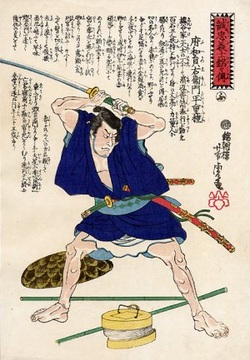 "A certain swordsman in his declining years said the following:
In one's life, there are levels in the pursuit of study. In the lowest level, a person studies but nothing comes of it, and he feels that both he and others are unskillful. At this point he is worthless. In the middle level he is still useless but is aware of his own insufficiencies and can also see the insufficiencies of others. In a higher level he has pride concerning his own ability, rejoices in praise from others, and laments the lack of ability in his fellows. This man has worth. In the highest level a man has the look of knowing nothing.
These are levels in general. But there is one transcending level, and this is the most excellent of all. This person is aware of the endlessness of entering deeply into a certain Way and never thinks of himself as having finished. He truly knows his own insufficiencies and never in his whole life thinks that he has succeeded. He has no thoughts of pride but with self-abasement knows the Way to the end. It is said that Master Yagyu once remarked, "I do not know the way to defeat others, but the way to defeat myself." Throughout your life advance daily, becoming more skillful than yesterday, more skillful than today. This is never ending."
- The Hagakure (1716)
"Swordsmanship is the art used at the border between life and death. It is easy to throw away your life and proceed toward death, but it is difficult not to make life and death two. The man who does not make life and death two should easily be able to act with complete freedom." - Tengu Geijutsuron (c.1720)
When the doctor
gives up, the tengu
is called.
- Doka (Poem of the Way) of the Kawabata-ryu
|